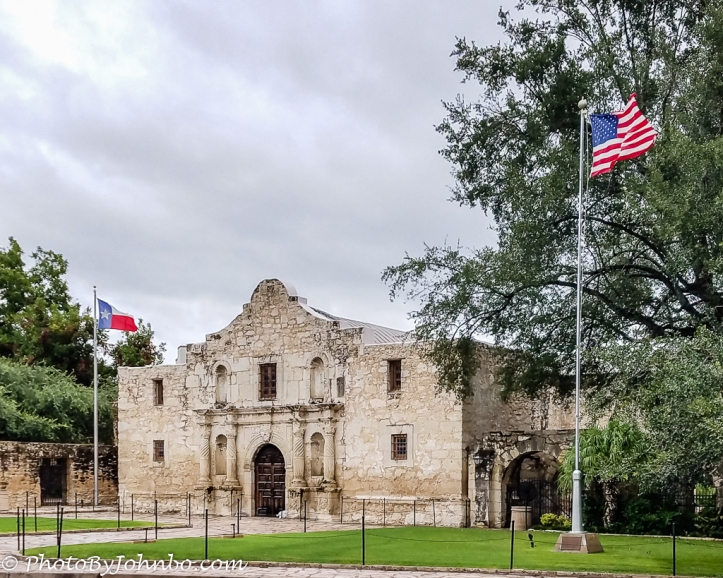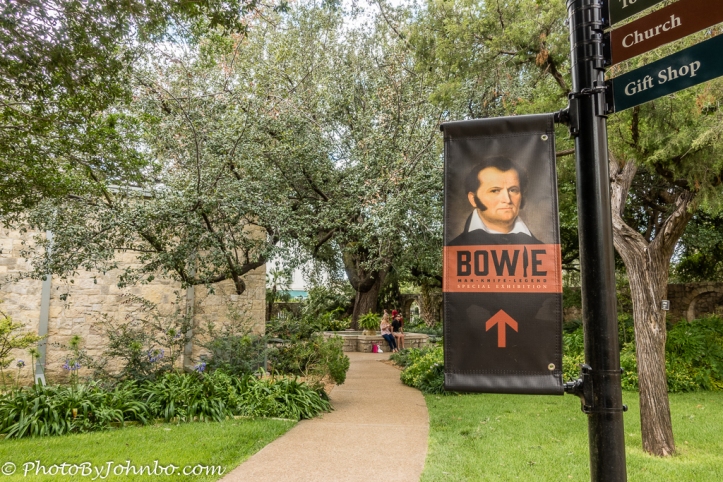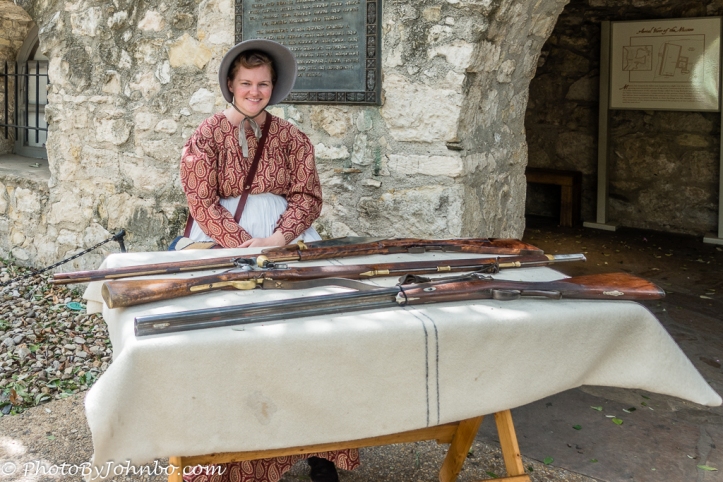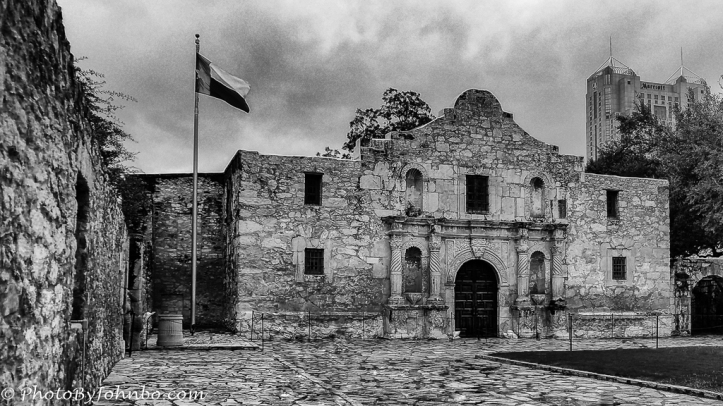While Hurricane Harvey was battering Houston, I was wandering around San Antonio under cloudy skies with light showers. That Sunday afternoon, the Alamo, along with many other attractions, was closed due to preparations for the possibility of a direct hit from the hurricane. Fortunately for San Antonio, the city was spared. Last week, I shared some images captured during a walk along the famed River Walk and the downtown area. One of my cell phone captures is a shot of The Alamo. This week, we take a look behind the fortress walls of the former mission turned fort and symbol of Texan independence.
On October 15, I shared a version of the opening photo as a Cellpic Sunday here. I am sharing a different version today as the one thing I didn’t like about the original was the chain and iron post fence that ring the property. If you compare the two photos, you’ll notice in the above photo that many of the closest posts and chains are gone. Lightroom came to my rescue and removed a distracting element in the foreground. You’ll notice I didn’t take them all out, but the ones remaining are much less imposing so I decided to leave them in. I enjoyed converting the image to black and white and processing it.
But enough about this specific photograph. Below is another view captured of the front entrance. Admission is free and you start by entering the original chapel, the building that is iconic. The compound was built on the San Antonio River by Spanish settlers around the year 1718. Known as Mission San Antonio de Valero, it was eventually abandoned. The compound was occupied variously by Spanish, Mexican, then Texan Independence soldiers in the early 1800s. There are lots of Internet history sites that can tell a much better story than I about what happened in 1835 and 1836 culminating in the loss of 200 Texans and others of some fame. Colonel James Bowie of the Texan Army joined Colonel William B. Travis and fought in several battles for Texas Independence. Former Tennessee Congressman and well-known frontiersman, Davey Crockett found himself at the Alamo during that fateful siege. Some controversy exists around the manner in which he lost his life, a fact I did not know until my visit here.
There are lots of Internet history sites that can tell a much better story than I about what happened in 1835 and 1836 culminating in the loss of 200 Texans and others of some fame. Colonel James Bowie of the Texan Army joined Colonel William B. Travis and fought in several battles for Texas Independence. Former Tennessee Congressman and well-known frontiersman, Davey Crockett found himself at the Alamo during that fateful siege. Some controversy exists around the manner in which he lost his life, a fact I did not know until my visit here.
Though the admission to the Alamo grounds is free, it comes with limitations. Interior photographs of all buildings are forbidden. There is much of interest worth photographing inside, but fortunately, the grounds are beautiful and well-kept so this blog post will not be left short of any images in the gallery.
Volunteers who play the role of settlers of the time walk the grounds and provide historical insight to the daily lives of settlers who lived and died at the hands of Mexican General Santa Anna. A few settlers were spared by Santa Anna to spread the word of what happens to members of the rebellion. The victory was not without cost as the Mexican General lost somewhere between 600 and 1600 soldiers in quelling the rebellion.
 On the day of my visit, one of the the buildings featured an exhibit of Bowie knifes and other historical info about Colonel Bowie. One note of trivia, the singer and musician David Bowie took his stage name from James Bowie. The singer/songwriter’s last name was Jones and when David went into the business, another famous Jones, Davey Jones, formerly of the Monkees, requiring the British-born musician to choose another name.
On the day of my visit, one of the the buildings featured an exhibit of Bowie knifes and other historical info about Colonel Bowie. One note of trivia, the singer and musician David Bowie took his stage name from James Bowie. The singer/songwriter’s last name was Jones and when David went into the business, another famous Jones, Davey Jones, formerly of the Monkees, requiring the British-born musician to choose another name.
 Tending a display of weapons of the period, this woman dressed in a period costume had some interesting stories to relate. The building behind her, the barracks during the time of the rebellion. The grounds of the Alamo are much smaller today than they were in 1836. Much of the area to the north and east were “gobbled up” by buildings in the downtown area. At some point the original walls were either moved or reconstructed in their current configuration. When you visit the site, be sure to go all the way to the eastern wall where there is a small interpretive center/snack/water bar. They run a historic video on a large screen monitor continuously that provided a great insight as to the history of the mission that became a fort and a symbol of independence. The gallery of images below were captured on my Sony camera, processed in 3-image HDR via lightroom. On most browsers, you can click on an image to enlarge it and to scroll through the gallery.
Tending a display of weapons of the period, this woman dressed in a period costume had some interesting stories to relate. The building behind her, the barracks during the time of the rebellion. The grounds of the Alamo are much smaller today than they were in 1836. Much of the area to the north and east were “gobbled up” by buildings in the downtown area. At some point the original walls were either moved or reconstructed in their current configuration. When you visit the site, be sure to go all the way to the eastern wall where there is a small interpretive center/snack/water bar. They run a historic video on a large screen monitor continuously that provided a great insight as to the history of the mission that became a fort and a symbol of independence. The gallery of images below were captured on my Sony camera, processed in 3-image HDR via lightroom. On most browsers, you can click on an image to enlarge it and to scroll through the gallery.
John Steiner



















I was at the Alamo about 18 years ago. People were quiet inside…hushed voices. Respectful. And I was surprised to see a Welsh flag among the array. I had no idea there was a Welshman fighting there. Beautiful photos.
Thank you. It was a somber place when I was there as well. So much history from the time of the mission to the revolution. Thanks for your comment!
What a great visit. Thanks for the historical overview. It makes me wonder is Pee Wee’s bike still in the basement?
Didn’t see it..l but then, I didn’t go in the basement. 😀